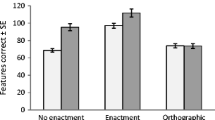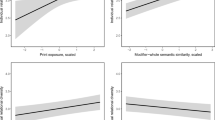Abstract
Children of the ages of 4 and 7 years recalled nouns from subject-verb-object sentences more efficiently than from noun pairs. Verbs were either stative or active. Preschoolers recalled more nouns from active than stative phrases, whereas the older children showed no such difference, either in a blocked (Experiment 1) or mixed list (Experiment 2) design. Whereas interaction rather than action seems critical for older children, younger children seem better able to retrieve words from action than from stative representations.
Similar content being viewed by others
References
Begg, I., and Young, B. J. (1978). An organizational analysis of the form class effect.J. Experimental Child Psychol. 23:503–519.
Bloom, L. (1970).Language Development: Form and Function in Emerging Grammars, M.I.T. Press, Cambridge, Mass.
Bloom, L., Hood, L., and Lightbown, P. (1975).Structure and Variation in Child Language, Monographs of the Society for Research in Child Development, 40 (2, serial no. 160).
Bloom, L., and Lahey, M. (1978).Language Development and Language Disorders, Wiley, Toronto, Canada.
Braine, M. D. S., and Wells, R. S. (1978). Case-like categories in children: the actor and some related categories.Cognitive Psychol. 10:100–122
Bruner, J. S. (1966). On cognitive growth: I& II. In Bruner, J. S., et al. (eds.),Studies in Cognitive Growth, Wiley, New York.
Dunn. L. M. (1965).Expanded Manual for the Peabody Picture Vocabulary Test, Minesota American Guidance Service.
Greenfield, P. M., and Smith, J. H. (1976).The Structure of Communication in Early Language Development, Academic, New York.
Harris, J. B. (1964).Children's Drawings as Measures of Intellectual Maturity: A Revision and Extension of the Goodenough Draw-A-Man Test, Harcourt, Brace, New York.
Kee, D. W., and Rohwer, W. D., Jr. (1974). Response and associative phrase components of elaborative prompt effects in children's noun-pair learning.J. Experimental Child Psychol. 18:62–71.
Levin, J. R. (1970). Factors related to the sentence facilitation of paired-associate learning: some characteristics of verbs.J. Educational Psychol. 61:431–439.
Moran, L. J. (1973). Comparative growth of Japanese and North American cognitive dictionaries.Child Development 44:862–865.
Nelson, K. (1977). The syntagmatic-paradigmatic shift revisited: a review of research and theory.Psycholog. Bull. 84:93–116.
Nelson, K. (1978). Semantic memory. In Nelson, K. E., (ed.),Children's Language, Vol. 1, Gardner, New York.
Paivio, A. (1971).Imagery and Verbal Processes, Holt, New York.
Piaget, J. (1952).The Origins of Intelligence in Children, International University Press, New York.
Prawat, R. S., and Cancelli, A. A. (1977). Semantic retrieval in young children as a function of type of meaning.Develop. Psychol. 13:354–358.
Rinsland, R. H. (1945).A Basic Vocabulary of Elementary School Children, MacMillan, New York.
Rohwer, W. D., Jr. (1966). Constraint, syntax, and meaning in paired-associated learning,J. of Verbal Learning and Verbal Behavior 5:541–547.
Rohwer, W. D., Jr. (1970). Images and pictures in children's learning.Psycholog. Bull. 73:393–403.
Rohwer, W. D., Jr., and Levin, J. R. (1968). Action, meaning, and stimulus selection in paired-associate learning.J. of Verbal Learning and Verbal Behavior 7:137–144.
Rohwer, W. D., Jr., Lynch, S., Levin, J. R. and Suzuki, N. (1967). Pictorial and verbal factors in the efficient learning of paired-associates.J. Educational Psychol. 58:278–284.
Starr, S. (1975). The relationship of single words to two-word utterances.Child Development 46:701–708.
Van der Veur, B. W. (1976). Imagery ratings of 1,000 frequently used words.J. Educational Psychol. 67:44–56.
Author information
Authors and Affiliations
Rights and permissions
About this article
Cite this article
Lempert, H., Kinsbourne, M. How young children represent sentences: Evidence from the superiority of noun recall from action as compared to stative sequences. J Psycholinguist Res 10, 155–166 (1981). https://doi.org/10.1007/BF01068035
Received:
Issue Date:
DOI: https://doi.org/10.1007/BF01068035




